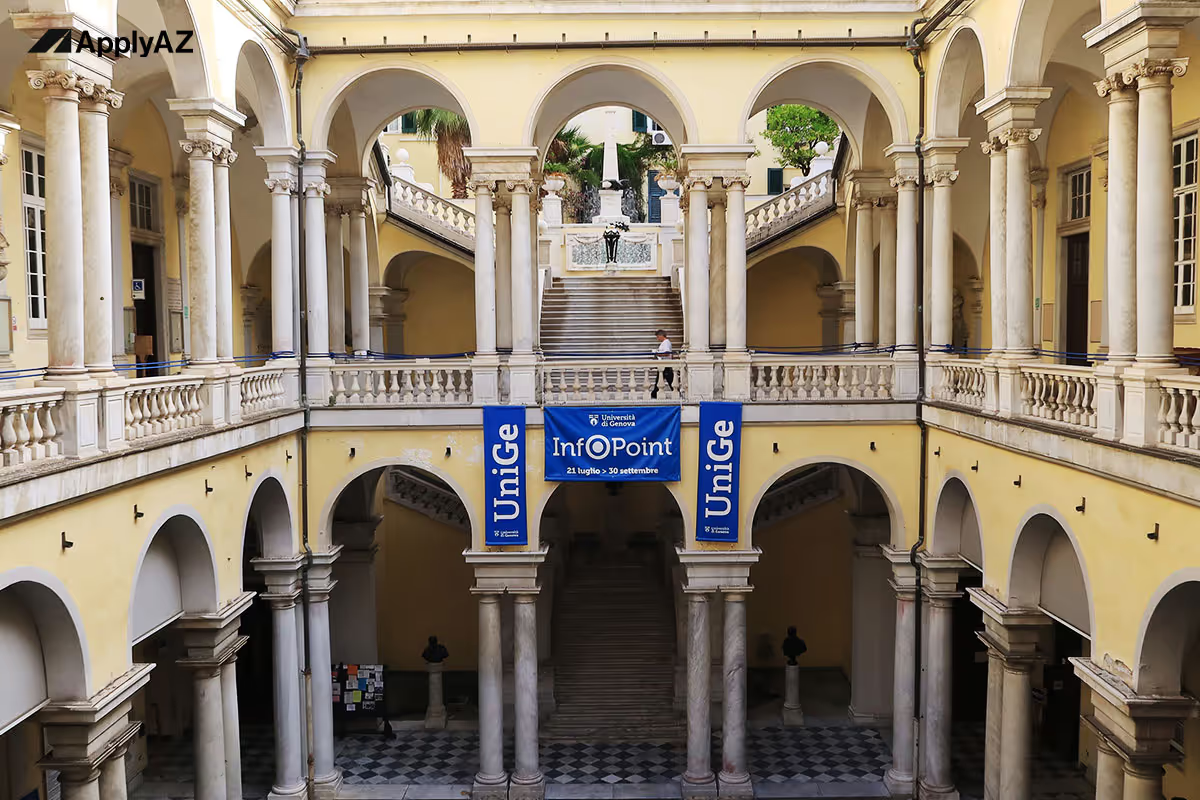Heading
Heading








University of Genoa
English‑taught programmes in Italy: why choose the University of Genoa
Founded in 1481 and consistently ranked among Europe’s leading maritime and engineering hubs, the University of Genoa offers more than 40 degree tracks taught partly or fully in English. This makes it one of the most versatile options for students seeking English‑taught programs in Italy while paying the regulated fees of public Italian universities. Incomes under specific thresholds can unlock the DSU grant, bringing total costs close to the levels often associated with tuition‑free universities Italy commentators mention. Key departments include naval architecture, robotics, computer science, biotechnology, and economics—each anchored by research centres that attract EU Horizon funding and private‑sector contracts.
Living and learning in a historic port city
Genoa stretches between mountains and sea, giving students a mild climate—winter averages 10 °C and summers hover around 28 °C. Shared flats in neighbourhoods like San Fruttuoso or Albaro cost roughly €300–€350 per month, and a €25 student travel pass covers buses, funiculars, and seaside trains. Cafeteria meals drop to €4 or even zero when the DSU grant applies. Cultural life blends Renaissance palaces, street‑art lanes, and open‑air concerts on the harbour. University sports clubs organise sailing, climbing, and coastal hikes, while language‑exchange cafés help you practise Italian after lectures.
Careers, internships, and industry links
Genoa is Europe’s busiest Mediterranean port and the core of Italy’s “Blue Economy.” Maritime giants, shipyards, and logistics groups recruit engineering and business students for roles in vessel design, supply‑chain analytics, and environmental compliance. The city also hosts the Italian Institute of Technology, famous for humanoid robots and smart materials—ideal for internships in AI, neuroscience, or nanotech. Biomedical start‑ups cluster around the university hospital, offering traineeships in gene therapy and medical imaging. Tourism and yachting sectors create seasonal part‑time jobs, useful for earning while studying. Career Services run bilingual CV workshops and link graduates to Erasmus+ traineeships across the EU.
Funding and academic support
Tuition scales from about €600 to €2 500 per year, depending on family income. Scholarships for international students in Italy include merit awards for high GPAs, fee waivers for refugee status, and lab assistantships that pay hourly. The DSU grant can waive tuition entirely, provide free meals, and contribute up to €7 000 toward rent and books—renewable when you pass 30 ECTS each year. The International Student Office helps with visa paperwork, health insurance, and accommodation lists, while the Language Centre offers free Italian courses from A1 to C1.
An inviting mix of heritage and innovation
Studying in Genoa means analysing wave mechanics in class and watching cargo ships glide past medieval city walls after hours. It means prototyping underwater drones in cutting‑edge labs, then testing them in the Ligurian Sea. Most of all, it means joining a diverse student body that values both tradition and forward‑thinking research. Choose Genoa if you want the networking ease of a medium‑sized city, the research muscle of a centuries‑old university, and cost structures that remain manageable thanks to Italy’s public‑education model and the DSU grant.
Ready for this programme?
If you qualify and we still have a spot this month, we’ll reserve your place with ApplyAZ. Our team will tailor a set of best-fit majors—including this course—and handle every form and deadline for you. One upload, many applications, guaranteed offers, DSU grant support, and visa coaching: that’s the ApplyAZ promise. Start now and secure your spot before this month’s intake fills up.
Architectural Composition (LM‑4) at University of Genoa
1. Why this English‑taught programme in Italy balances design, theory, and budget
Choosing English‑taught programs in Italy lets you deepen architectural craft without leaving Europe. This LM‑4 pathway helps you study in Italy in English while paying the regulated fees that apply to public Italian universities. With income‑linked tuition and the DSU grant, overall costs can drop near the figures often quoted for tuition‑free universities Italy observers mention. Faculty members publish in Architectural Research Quarterly and advise UNESCO on coastal heritage, so you gain mentors who shape real policy and award‑winning buildings.
The course merges compositional theory, parametric tectonics, and climate‑responsive design. Studios tackle adaptive reuse, coastal resilience, and social housing—all timely for architects entering a net‑zero economy. Because intake numbers stay below 40, every student receives weekly desk critiques and one‑to‑one feedback.
2. Curriculum, design studios, and elective freedom
Semester 1 – foundations and hand‑to‑digital fluency
- Advanced Architectural Composition I (12 ECTS)
Investigate proportion, typology, and precedent through small‑scale interventions. Sketch analyses of Carlo Scarpa and Lina Bo Bardi feed rapid VR models. - History and Theory of Contemporary Architecture (6 ECTS)
Trace movements from Rationalism to Post‑Digital Craft; short essays test critical reading. - Sustainable Building Physics (6 ECTS)
Learn daylight, airflow, and envelope optimisation using Ecotect and EnergyPlus. - Digital Fabrication Workshop (4 ECTS)
Laser‑cut sectional models, 3‑D print joints, and CNC mill formwork. - Seminar: Writing about Architecture (2 ECTS)
Craft abstracts, manifestos, and grant proposals in concise English.
Semester 2 – contextual design and urban systems
- Advanced Architectural Composition II (12 ECTS)
Site: water‑edge industrial strip. Teams propose mixed‑use housing that lifts above floodplain levels. Weekly pin‑ups stress social context, compositional clarity, and low‑carbon materiality. - Urban Morphology and Public Space (6 ECTS)
Map street networks, analyse density, and test infill typologies. GIS labs reveal pedestrian heat maps. - Structure and Detail (6 ECTS)
Hybrid timber–steel frames and CLT diaphragm design; workshop visits to a local off‑site prefab plant. - Elective A (4 ECTS) – choose Computational Design, Landscape Ecology, or Heritage BIM.
Semester 3 – integrated studio and professional prep
- Integrated Design Studio (14 ECTS)
Mixed juries of engineers, sociologists, and public officials critique a community centre proposal from concept to construction documents. Each group produces a BIM model, LCA metrics, and 1:1 mock‑up of a façade slice. - Professional Practice and Ethics (4 ECTS)
EU procurement, fee structures, copyright, and contract administration; case studies on ethical dilemmas. - Construction Law and Project Management (4 ECTS)
Roles, liabilities, tendering, Gantt planning, and cost tracking. - Elective B (4 ECTS) – options: Urban Resilience Design, Digital Heritage Conservation, or Advanced Lighting Simulation.
Semester 4 – internship and thesis research
- Professional Internship (14 ECTS)
Minimum 350 hours at a design office, engineering consultancy, or research practice. Tasks vary from parametric envelope scripting to adaptive‑reuse feasibility reports. - Master’s Thesis (16 ECTS)
Original design or written dissertation. Recent titles: “Modular Timber Housing for Coastal Migration,” “Algorithmic Pattern‑Language for Mediterranean Courtyards,” and “Retrofit Strategies for Post‑War Social Blocks.” Projects aim for peer‑review publication or competition entry.
3. Facilities, software stack, and research links
- Design Studios – 24‑hour access, pin‑up walls, and VR headsets for immersive walkthroughs.
- Digital Fabrication Lab – FDM and SLA 3‑D printers, 5‑axis CNC, robotic arm for clay extrusion, and metal laser cutter.
- Environmental Chamber – test façade prototypes under real temperature, humidity, and solar loads.
- VR Cave – cave‑automatic virtual environment supports 1:1 interior evaluation.
- BIM Hub – Revit, ArchiCAD, Grasshopper, Rhino, and Dynamo licences on high‑spec workstations.
- Library and Material Archive – samples of cork bricks, algae‑based bioplastics, and recycled concrete panels.
Research groups partner with European networks on circular construction, sea‑level adaptation, and AI‑assisted heritage analysis. LM‑4 students often co‑author conference papers or assemble competition teams that win EUROPAN and Young Talent Architecture Awards.
4. Careers, certifications, and global mobility
Sought‑after skills
- Generate concept diagrams and parametric scripts quickly.
- Compose spatial narratives that respect context and climate.
- Produce BIM deliverables compatible with ISO 19650 workflows.
- Calculate daylight autonomy, embodied carbon, and thermal comfort.
- Navigate EU procurement and cross‑disciplinary teamwork.
Career paths
- Junior architect progressing to project lead in EU offices.
- BIM coordinator or computational designer in international practices.
- Sustainability consultant focusing on passive‑design audits.
- Doctoral researcher in architectural theory or digital heritage.
Holders of the LM‑4 qualify for the Italian State Examination (Esame di Stato) and subsequent registration in the Order of Architects. The curriculum also preps graduates for LEED GA and WELL AP exams.
Internship network
Partner offices include Renzo Piano Building Workshop, Stefano Boeri Interiors, BIG’s Copenhagen studio (via Erasmus+), and heritage consultancies restoring UNESCO port arsenals. Students often extend internships into six‑month contracts.
5. Funding and cost management
Tuition
As part of public Italian universities, fees scale with income: roughly €900–€2 500 per year. Installment plans ease budgeting.
DSU grant
Qualifying students can receive:
- Full tuition waiver.
- Meal vouchers or free canteen access.
- Rent allowance or bed in a subsidised hall.
- Annual stipend up to €7 000 if you pass at least 30 ECTS per year.
Additional scholarships
- Merit fee reductions for GPA ≥ 3.5/4.0.
- Teaching assistantships in first‑year design drawing labs.
- Erasmus+ credits to study urban morphology in Barcelona or timber tectonics in Helsinki.
- Competition grants that cover travel to present at international crits.
ApplyAZ guides you through financial‑proof paperwork, ensuring dates and translations match consulate criteria.
6. Admissions roadmap and ApplyAZ support
Entry requirements
- Bachelor’s in Architecture, Architectural Engineering, or related (minimum 180 ECTS).
- Portfolio showing design development, technical drawings, and conceptual thinking.
- English proficiency IELTS 6.5/TOEFL iBT 90 or proof of English‑medium bachelor.
- Motivation letter, transcript, CV, passport scan, and two references.
- Online interview: five‑minute portfolio presentation, plus Q&A on design approach and research interests.
ApplyAZ audits your coursework for structural, history, and technology prerequisites, suggests bridging MOOCs when gaps appear, and assembles your DSU application pack well before peak deadlines.
7. Key takeaways—why place Architectural Composition at the top of your list?
- Holistic approach merging compositional theory, computational craft, and sustainability metrics.
- Affordable via fee scales of public Italian universities and robust DSU grant support.
- Research intensity opens opportunities to co‑author papers and compete internationally.
- Global employability: BIM, LCA, and parametric scripting skills translate across borders.
- Personalised mentorship from professors recognised by RIBA and UNESCO.
Ready for this programme?
If you qualify and we still have a spot this month, we’ll reserve your place with ApplyAZ. Our team will tailor a set of best-fit majors—including this course—and handle every form and deadline for you. One upload, many applications, guaranteed offers, DSU grant support, and visa coaching: that’s the ApplyAZ promise. Start now and secure your spot before this month’s intake fills up.

They Began right where you are










